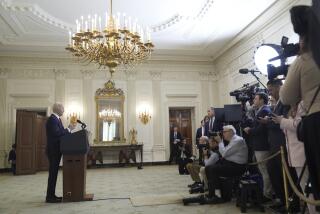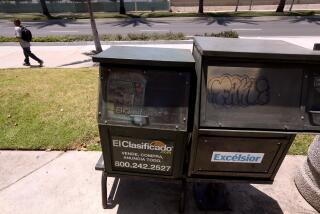SMALL BUSINESS : At Issue : E-Mail, Web Sites May Offer Relief From Telephone Chaos
- Share via
Small businesses continue to suffer under phone service deregulation, as shown by the recent bankruptcy declaration of Conxus paging service and a new survey of phone users in the 310 and 925 area codes.
Instead of lower costs and better service, deregulation has brought communication chaos. Not only are businesses having to pay thousands of dollars to cope with changing area codes, but their actual livelihood is threatened when phone service companies go out of business or area codes change.
Six state legislators are frantically trying to craft relief measures before Friday, when the legislative calendar ends. But for small firms and single-person businesses, the immediate solution may, ironically, be more phone-related devices: namely, computer e-mail and Web sites.
Although the days are long gone when phone numbers bore personalized, neighborhood descriptions such as Amherst 43762 or Bristol 54117, e-mail addresses and Web sites still provide a more personal address than the 11-digit number doled out by phone companies. And in a sea of shifting phone numbers, e-mail and Web sites provide a constant means of communication, avoiding problems such as those facing Conxus Communications Inc. subscribers.
The Greenville, S.C.-based company declared bankruptcy 2 1/2 weeks ago after signing nearly 80,000 subscribers nationwide to Pocketalk, a pager that works almost like a tape recorder. The message sender’s voice and message are played back when the page is answered.
But these users were suddenly left without service when Conxus could find no financial backers to replace its previous backer and pager manufacturer, Motorola Inc. Conxus stopped answering customers’ calls, leaving small retailers such as Karla Washington to face irate customers.
Washington, who operates D’Menace Copies & Communications in Inglewood with her husband, Dennis, sold 27 of the pagers at $99 apiece. The pagers are so unique that they can’t be used by other paging services, so the devices are essentially useless, Washington said. Reimbursing customers for the now-dead units would mean a big hit for her small business, she said.
Further, Washington said she sympathizes with other small businesses. Some of her customers who operate their own firms told her that they were expecting deals or financing and had listed the pager number as a contact number. One man had prepared 400 copies of his resume with the pager number.
“The bigger company went out of business and it caused this snowballing effect,” Washington said. “Someone needs to protect the small-business people.”
Meanwhile, a survey commissioned by the California Small Business Assn. and other organizations provided some new economic impact data on area code splits and overlays. Circulated in August to 581 businesses in the 310 and 925 area codes, the survey showed that businesses estimated costs of about $2,000 to print new business cards, letterhead and marketing materials when an area is split and a new area code created. For businesses in the 310 area code, the median cost came to $2,500. Of the businesses surveyed in the 310 area code, 25.9% said their costs would be $5,000 or more.
By contrast, an overlay (in which only new phone lines in an area receive the new area code) had less economic impact. The median cost came to only $150. Nearly a third of the businesses estimated zero costs, according to the survey.
A little more than 70% of the businesses surveyed said changing an area code would make it harder for customers to reach their businesses.
The survey, an update to a similar 1996 survey, was meant to help the California Public Utilities Commission reach a decision Sept. 16 in San Francisco on two pending area codes.
Commissioners must decide on the 424/310 area code overlay and whether the 818 area code should be split into two area codes or take an overlay. A state administrative law judge had initially ruled in favor of an 818 overlay, but in late August reversed himself, citing outrage over the 310 overlay, and opted for a split. The PUC has to make a final decision in that matter.
But the PUC decision could be rendered moot by a recently appointed state legislative committee that is trying to hash out a compromise to Assembly Bill 818, a measure proposed by Assemblyman Wally Knox (D-Los Angeles).
Knox is asking for a number of measures to preserve existing area codes and block more splits and overlays. Those measures include creating separate area codes for faxes, computers and other technology devices and issuing phone numbers to phone service providers and cellular phone companies in smaller blocks (1,000 instead of the current 10,000). These companies often don’t use all the numbers assigned them. By issuing phone numbers in smaller blocks, the supply of available numbers would better reflect the number of users. In California, for example, an estimated 180 million phone numbers have been assigned to carriers and only 30 million of the phone numbers are in actual use.
The committee is facing a Friday deadline, but even if the legislators succeed in drawing up a proposal, some of the committee’s measures would have to be approved by the Federal Communications Commission, where telecommunications companies employ an army of lobbyists to argue that costs and technology prohibit them from conserving phone numbers under measures such as number pooling.
The war against multiplying area codes could take years. So, in truth, there is no immediate solution, which is why e-mail and Web sites may be the stop-gap measure for now--even though online service providers have their own brand of problems.
Although electronic media rely on phones and are subject to changing area codes, the bottom line is that a business owner has to readjust the computer only once to continue dialing out to the online service provider and receiving electronic mail under the new area code. Customers who use e-mail and Web sites would experience no glitch on their end, regardless of the area code change.
Already, many technology-savvy business owners routinely list on business cards their work phone, fax number, pager, cell phone, e-mail and Web site. A Beverly Hills auto dealer runs an ad saying the company can be reached telephonically, geographically and in cyberspace, and provides addresses and numbers for all three.
The cost of computers and computer online services may seem prohibitive, but those costs have to be weighed against the costs of lost business during the communication chaos that is likely to last for at least the next five years. For fledgling and growing businesses, that lost business may not even be measurable, but harmful, nonetheless.
As Washington said, “It’s the not knowing that gets people, not knowing how much you lost.”
*
Times staff writer Vicki Torres can be reached at (213) 237-6553 or at [email protected].
More to Read
Inside the business of entertainment
The Wide Shot brings you news, analysis and insights on everything from streaming wars to production — and what it all means for the future.
You may occasionally receive promotional content from the Los Angeles Times.










